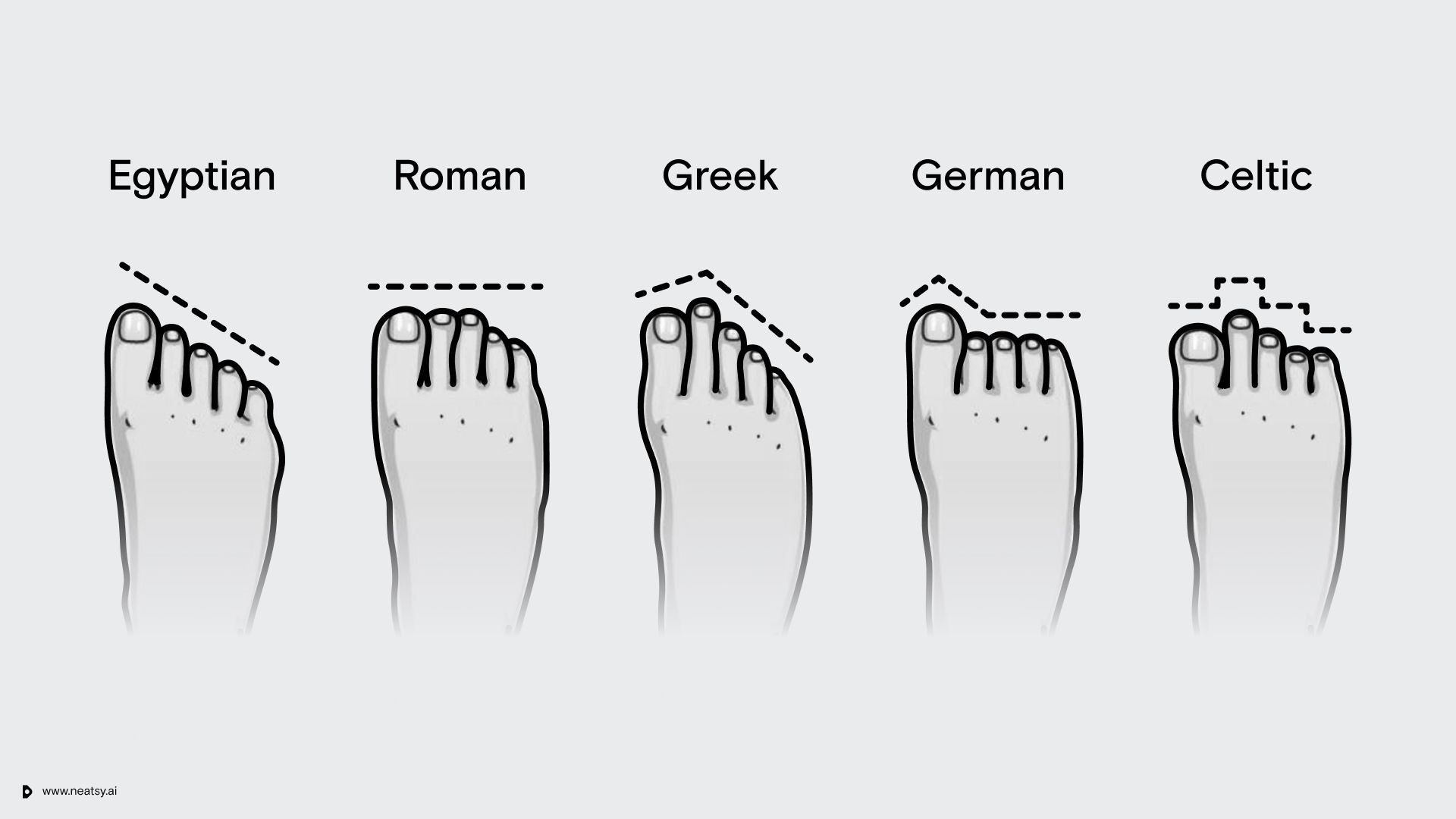The evolution of your feet
Uncover the connection between your foot shape & ancestors' origin. Learn about 5 main types of feet & their unique characteristics. Trace your foot shape back to ancient populations. Explore the history & science behind your feet on our website.

Interest in genetics and origin has long stimulated the emergence of evolutionary theories and the development of science. One such theory posits that the shape of your foot can be traced back to the ancient populations, to which your ancestors belonged.
Content:
- What types of feet exist?
- “Greek feet” - the standard for sculptors
- “Roman feet” - a measure of length
- “Celtic feet” - a mixture of cultures
- “Egyptian feet” - artificial fingers
- The connection of feet and geographical origin
What types of feet exist?
According to most biological theories, there are five main types of feet, differentiated by the length of the toes, and the line they form.

Greek: The second toe protrudes forward, relative to all the others, including the “big toe.”
Roman: The first three fingers are the same length, while the last two are usually shorter.
Celtic The “big toe” is short, the second is longer than the rest, and the others decrease in size, descending towards the smallest toe
German: The “big toe” is typically large, while the rest are the same size.
Egyptian: The toes decrease in size, evenly (ladder), from the big toe, to the pinky toe.
It is assumed that people with “Greek feet” had Greek ancestors, while those with “Egyptian feet” had Egyptian ancestors, and so on; a theory that emerged in the 19th century, when the idea of belonging to "Germanic" or "Egyptian" populations, associated with ethnic homogeneity, came into vogue.
The “Greek foot” - a standard for sculptors
If one's second toe is longer than the rest, it is most likely a “Greek” type of foot. But one should not immediately think that this indicates a Greek origin.
If you have seen ancient Greek statues, you may have noticed that their feet have a second toe that is longer than the others and this is because sculptors and those in the Greek architecture and art worlds considered them ideal.
Meanwhile, in medicine, the long second toe is called "Morton's finger". This type of anatomy has the potential to cause pain when walking, as it affects the distribution of body weight and pressure on the foot. On the other hand, a 2004 study showed that this anatomical feature is inherent in professional athletes and can positively affect athletic performance. Perhaps that is why the “Greek foot” is also called the "burning foot".
Either way, scientists agree that this foot shape is a trait that is inherited, and is more often seen in men, than women.
The “Roman foot” - a measure of length
The Romans left their anatomical traces throughout Europe and North Africa during the conquests, and they famously invented the "foot" - as a measure of length - which is still used in the US and UK, today.
The “Roman foot” can be recognized by three toes of the same length, starting with the first, which is believed to be a characteristic of about a quarter of the world's population. It is often found in Roman art, although many statues can also be seen with a Greek foot, as stated earlier. That said, the Romans were known to copy the works of Greek sculptors.
People with “Roman” shaped feet often find it more difficult to find comfortable shoes. These issues are especially pronounced when the fronts of the shoes are narrow i.e. stilettos and high heels, because it puts more pressure on the ball of the feet.
Fun fact: The bones of the foot make up 25% of all bones in the human body: 26 bones and 33 joints!
The “Celtic foot” - a mixture of cultures
The Celts are associated with Western Europe, especially Britain, but their exact origins are uncertain; so it’s not surprising that their feet and toes also speak of a mixture of different cultures.
The “Celtic foot” shape is actually a combination of the Germanic and Greek toes, in that the second finger is longer than the others, and the first and third are almost the same length.
Genetic research has shown that regions of the UK, such as Cornwall, Scotland, Wales and Northern Ireland, where Celtic roots predominate, are genetically different from each other, thus, there is no single Celtic genetic group. According to DNA samples of more than 6000 Europeans, it appears that multiple populations migrated to the territory of the modern United Kingdom over the past 10 thousand years.
The “Egyptian foot” - artificial toes
The Egyptian foot looks neat: in that the toes decrease evenly, from largest to smallest. In fact, if you draw an imaginary line from the tip of the first toe to the littlest toe, you get a straight line at an angle of 45 degrees.
Interestingly, researchers from the University of Manchester found an ancient mummy with two toe prostheses, one made of papier-mâché and the other made of wood and leather.
In an effort to understand this finding, the scientists decided to experiment and made their own version of the toe prosthesis, and the results showed that they likely helped people who had lost their big toes, walk in sandals typical of ancient Egyptian times.
Interestingly, 70–80% of the Japanese population has an Egyptian type of foot, so Japanese-manufactured shoes are often made to accommodate this anatomical feature. In fact, some shoe manufacturers actually advertise that their products are designed for the Egyptian foot.
Egyptian feet were originally thought to be at higher risk of ingrown toenails than others. However, the Japanese Medical School of Nippon conducted a comparative study of Egyptian, Greek and Celtic feet and found that people with Egyptian toes, on the contrary, had this problem less frequently…and now you know:-)
Connection of Feet and Origin
Hopefully you’ve learned a bit more about the five most common types of foot, as well as their medical and orthopedic features, and even some wayward myths. Most would like to believe that the shape of their foot holds secrets about where their distant ancestors lived, however, there is still no clear scientific justification for this theory.
Case in point: despite the fact that, according to statistics, the “Greek foot” prevails among the modern population of Greece, it is also found among the natives of Australia, who are unlikely to be descendants of the ancient Greeks. Scientists now think that the elongated toe may just be an evolutionary adaptation that aids in running.
Similarly, in ancient times the “Greek foot” was the standard of beauty (as evidenced by its place in the art of the ancient Greeks, Egyptians and Romans; Venus de Milo and the Statue of Liberty), especially in the 19th century, however, it is now thought that that anatomical preference may have over-influenced the development of the theory at large.
So, as you look down at your feet, just know that what you see is likely a mix of ethnicity, ancestry and evolution…and regardless of the shape, it’s pretty amazing what those feet are able to provide…a pretty smooth ride…so treat them well!
The Venus de Milo and the Statue of Liberty have a Greek type of foot
Sources:
• Aigbogun, E, O et al. Morton’s Toe: Prevalence and Inheritance Pattern among Nigerians, 2019
• Callaway, E. UK Mapped Out By Genetic Ancestry, 2015
• NHS. Ingrown Toenail, 2018
• Ogawa, R and Hyakusoku, H. Does Egyptian Foot Present an Increased Risk of Ingrown Toenail, 2006
• Pilikian, H, I. Why We Should Remember the Armenians, 2014
• Science Daily. Egyptian Toe Tests Show They’re Likely to Be the World’s Oldest Prosthetics, 2012
• Vounotrypidis, P and Noutsou, P. The Greek Foot: Is It a Myth or Reality? An Epidemiological Study in Greece and Connections to Past and Modern Global History, 2015
• Kulthanan T et al., A study of footprints in athletes and non-athletic people, 2005
• MIT Technology Review, 2019